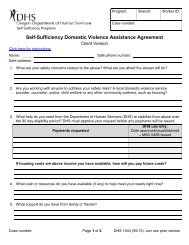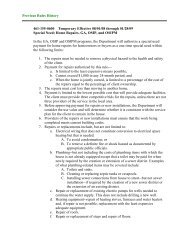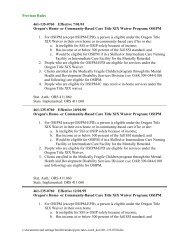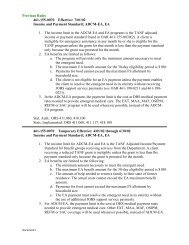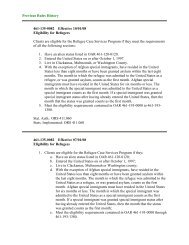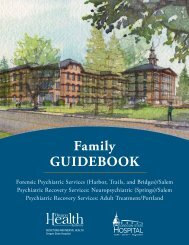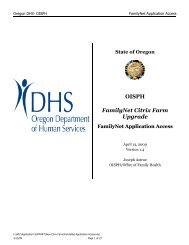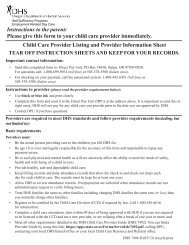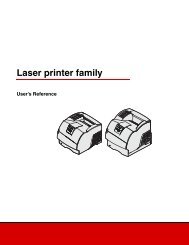Quick-Start Guide to the DHS and OHA Training Standards
Quick-Start Guide to the DHS and OHA Training Standards
Quick-Start Guide to the DHS and OHA Training Standards
Create successful ePaper yourself
Turn your PDF publications into a flip-book with our unique Google optimized e-Paper software.
<strong>Quick</strong>-<strong>Start</strong> <strong>Guide</strong> <strong>to</strong> <strong>the</strong><br />
<strong>DHS</strong> <strong>and</strong> <strong>OHA</strong> <strong>Training</strong> St<strong>and</strong>ards<br />
v2.0 2013
Introduction<br />
Question: How do you create consistent, high-quality training?<br />
Answer: Have st<strong>and</strong>ards, use a model <strong>and</strong> provide resources <strong>and</strong> <strong>to</strong>ols.<br />
Through <strong>the</strong> Employee <strong>Training</strong> Council, <strong>the</strong> Oregon Department of Human Services (<strong>DHS</strong>) <strong>and</strong> <strong>the</strong> Oregon<br />
Health Authority (<strong>OHA</strong>) have adopted st<strong>and</strong>ards for <strong>the</strong> design <strong>and</strong> delivery of departmental training.<br />
This <strong>Quick</strong>-<strong>Start</strong> <strong>Guide</strong> will help you apply <strong>the</strong> <strong>DHS</strong> <strong>and</strong> <strong>OHA</strong> <strong>Training</strong> St<strong>and</strong>ards <strong>to</strong> your work. It contains<br />
questions <strong>to</strong> guide you through <strong>the</strong> Pre-Design, Design <strong>and</strong> Delivery stages of <strong>the</strong> instructional design model.<br />
Like any quick-start <strong>to</strong>ol, it gets you started; for complete information, it points you <strong>to</strong> o<strong>the</strong>r sources.<br />
One of <strong>the</strong>se sources is <strong>the</strong> online <strong>DHS</strong> <strong>and</strong> <strong>OHA</strong> <strong>Training</strong> St<strong>and</strong>ards Manual — a companion document that<br />
has detailed information on many of <strong>the</strong> <strong>to</strong>pics presented in this guide. The manual has resource information<br />
<strong>and</strong> printable sections with Checklists <strong>and</strong> Templates <strong>and</strong> Trainer Tools. Follow this link, www.dhs.state.<br />
or.us/training/Tools.htm, <strong>to</strong> <strong>the</strong> manual.<br />
If you need assistance with <strong>the</strong> guide or manual, call 503-947-5457 <strong>to</strong> speak with an Organization <strong>and</strong><br />
Employee Development Services staff member.<br />
If you have problems with <strong>the</strong> links in this guide, please refer <strong>to</strong> <strong>the</strong> Web address disclaimer statement on<br />
page 18.<br />
1<br />
Complete information is online in <strong>the</strong> <strong>DHS</strong> <strong>and</strong> <strong>OHA</strong> <strong>Training</strong> St<strong>and</strong>ards Manual at www.dhs.state.or.us/training/Tools.htm (case sensitive).
The ADDIE Model of Instructional System Design (ISD)<br />
This model, developed by Florida State University <strong>and</strong> selected by <strong>the</strong> Armed<br />
Services in 1975 as <strong>the</strong> primary means for developing training, shows <strong>the</strong> five<br />
stages of instructional design. It has become an industry st<strong>and</strong>ard.<br />
There are questions <strong>to</strong> think about at each stage. The answers you come<br />
up with will help you produce training that incorporates <strong>the</strong> <strong>DHS</strong> <strong>and</strong> <strong>OHA</strong><br />
<strong>Training</strong> St<strong>and</strong>ards.<br />
(Go <strong>to</strong> <strong>the</strong> online <strong>DHS</strong> <strong>and</strong> <strong>OHA</strong> <strong>Training</strong> St<strong>and</strong>ards Manual if you need<br />
help answering <strong>the</strong> questions.)<br />
www.dhs.state.or.us/training/Tools.htm<br />
The following link offers detailed information on all <strong>the</strong> stages of ISD in what<br />
<strong>the</strong> author calls an Instructional System Development Manual. (The site has<br />
an odd name, but is filled with great training information. Click on <strong>the</strong><br />
<strong>Training</strong> tab.)<br />
www.nwlink.com/~donclark/hrd/sat.html<br />
Assess<br />
Design<br />
Develop<br />
Implement<br />
(You evaluate during each phase <strong>and</strong> at <strong>the</strong> end.)<br />
Evaluate<br />
2<br />
Complete information is online in <strong>the</strong> <strong>DHS</strong> <strong>and</strong> <strong>OHA</strong> <strong>Training</strong> St<strong>and</strong>ards Manual at www.dhs.state.or.us/training/Tools.htm (case sensitive).
What are <strong>the</strong> st<strong>and</strong>ards?<br />
<strong>DHS</strong> <strong>and</strong> <strong>OHA</strong> <strong>Training</strong> St<strong>and</strong>ards<br />
To ensure that training meets <strong>the</strong> following <strong>DHS</strong> <strong>and</strong> <strong>OHA</strong> st<strong>and</strong>ards, trainers should refer <strong>to</strong> <strong>the</strong> information<br />
found in this guide <strong>and</strong> in <strong>the</strong> online <strong>DHS</strong> <strong>and</strong> <strong>OHA</strong> <strong>Training</strong> St<strong>and</strong>ards Manual. <strong>Training</strong> materials are<br />
expected <strong>to</strong> conform <strong>to</strong> <strong>the</strong> <strong>DHS</strong> <strong>and</strong> <strong>OHA</strong> communication offices’ style guides. Principles of Adult Learning<br />
apply <strong>to</strong> all of <strong>the</strong> following:<br />
PRE-DESIGN<br />
At <strong>DHS</strong> <strong>and</strong> <strong>OHA</strong>, trainers will:<br />
• Assess whe<strong>the</strong>r training is appropriate <strong>and</strong> which training method is best suited <strong>to</strong> <strong>the</strong> need;<br />
• Involve cus<strong>to</strong>mers, managers, subject matter experts <strong>and</strong> partners in planning <strong>and</strong> pilots.<br />
DESIGN<br />
At <strong>DHS</strong> <strong>and</strong> <strong>OHA</strong>, trainers will:<br />
• Incorporate in<strong>to</strong> objectives, lesson plans, training approaches <strong>and</strong> evaluation:<br />
• Adult Learning Principles;<br />
• <strong>DHS</strong> <strong>and</strong>/or <strong>OHA</strong> missions, goals, core values <strong>and</strong> initiatives;<br />
• Concepts of diversity <strong>and</strong> cultural competence;<br />
• Industry st<strong>and</strong>ards (Robert Mager, Benjamin Bloom, Donald <strong>and</strong> James Kirkpatrick).<br />
• Select delivery methods using <strong>the</strong> <strong>DHS</strong> <strong>and</strong> <strong>OHA</strong> <strong>Training</strong> Methodologies — Decision <strong>Guide</strong>lines.<br />
3<br />
Complete information is online in <strong>the</strong> <strong>DHS</strong> <strong>and</strong> <strong>OHA</strong> <strong>Training</strong> St<strong>and</strong>ards Manual at www.dhs.state.or.us/training/Tools.htm (case sensitive).
Develop/present/implement<br />
At <strong>DHS</strong> <strong>and</strong> <strong>OHA</strong>, trainers will:<br />
• Create materials that:<br />
• Are relevant, legible, at <strong>the</strong> appropriate reading level <strong>and</strong> conform <strong>to</strong> <strong>DHS</strong> <strong>and</strong> <strong>OHA</strong><br />
design manuals;<br />
• Include concepts of diversity <strong>and</strong> cultural competence.<br />
• Be able <strong>to</strong>:<br />
• Facilitate, manage <strong>the</strong> classroom, question, give feedback;<br />
• Conduct learner-centered activities that promote retention <strong>and</strong> transfer of knowledge <strong>and</strong> skills;<br />
• Model <strong>the</strong> core values <strong>and</strong> demonstrate cultural competence;<br />
• Evaluate sessions using a learner-response questionnaire.<br />
Links <strong>to</strong> <strong>DHS</strong> <strong>and</strong> <strong>OHA</strong> communications manuals for style <strong>and</strong> publication guidelines:<br />
https://inside.dhsoha.state.or.us/asd/dhsoha-publications/writing-<strong>and</strong>-graphic-st<strong>and</strong>ards-manuals.<br />
html<br />
Additional links will be added when provided. See Web link information on page 18.<br />
4<br />
Complete information is online in <strong>the</strong> <strong>DHS</strong> <strong>and</strong> <strong>OHA</strong> <strong>Training</strong> St<strong>and</strong>ards Manual at www.dhs.state.or.us/training/Tools.htm (case sensitive).
Pre-Design<br />
In Pre-Design you answer <strong>the</strong> following questions:<br />
• What problem or problems need solving?<br />
• Who are <strong>the</strong> cus<strong>to</strong>mers, managers, subject matter experts <strong>and</strong> partners<br />
I should involve in this assignment?<br />
• What is <strong>the</strong> gap between <strong>the</strong> desired performance <strong>and</strong> <strong>the</strong> actual<br />
performance? Is it knowledge, skill or attitude that causes <strong>the</strong> discrepancy?<br />
• Can training solve this problem? Is it a performance problem? (More<br />
information will not change performance problems.) Did using Robert<br />
Mager’s material on assessment help me determine this?<br />
• Who is <strong>the</strong> audience? What knowledge <strong>and</strong> skills do <strong>the</strong>y already have?<br />
What knowledge <strong>and</strong> skills do <strong>the</strong>y need?<br />
• If training is <strong>the</strong> right solution for this audience, what method from<br />
<strong>the</strong> <strong>DHS</strong> <strong>and</strong> <strong>OHA</strong> <strong>Training</strong> Methodologies — Decision <strong>Guide</strong>lines is<br />
appropriate?<br />
Consulting Robert Mager’s Performance Model in <strong>the</strong> online <strong>DHS</strong> <strong>and</strong> <strong>OHA</strong><br />
<strong>Training</strong> St<strong>and</strong>ards Manual will help you decide if a non-training solution such<br />
as feedback or skill practice could solve <strong>the</strong> problem without training.<br />
www.dhs.state.or.us/training/Tools.htm<br />
For a complete description of <strong>the</strong> assessment analysis, go <strong>to</strong>:<br />
www.nwlink.com/~donclark/hrd/sat.html<br />
Assess<br />
Design<br />
Develop<br />
Implement<br />
Evaluate<br />
5<br />
Complete information is online in <strong>the</strong> <strong>DHS</strong> <strong>and</strong> <strong>OHA</strong> <strong>Training</strong> St<strong>and</strong>ards Manual at www.dhs.state.or.us/training/Tools.htm (case sensitive).
Design<br />
In <strong>the</strong> Design stage, you answer <strong>the</strong> following questions, develop objectives,<br />
<strong>and</strong> select training methods, activities <strong>and</strong> evaluation schemes <strong>to</strong> measure<br />
success. Then you transfer <strong>the</strong>se <strong>to</strong> lesson plans with enough detail that ano<strong>the</strong>r<br />
trainer could do <strong>the</strong> training.<br />
• How have I incorporated <strong>the</strong> <strong>DHS</strong> <strong>and</strong>/or <strong>OHA</strong> missions, goals, core<br />
values <strong>and</strong> initiatives in<strong>to</strong> my design? Is this clear <strong>to</strong> o<strong>the</strong>rs?<br />
• Who are <strong>the</strong> cus<strong>to</strong>mers, managers, subject matter experts <strong>and</strong> partners<br />
I am including in planning <strong>and</strong> pilots?<br />
• How am I checking my design for cultural competence? Who can help me?<br />
• How does my design incorporate <strong>the</strong> Adult Learning Principles?<br />
• How do <strong>the</strong> training actions (activities, scenarios, lessons) honor <strong>the</strong> life<br />
experience <strong>and</strong> learning that <strong>DHS</strong> <strong>and</strong> <strong>OHA</strong> employees bring <strong>to</strong> my sessions?<br />
Here is one example of Adult Learning Principles. See <strong>the</strong> Design section of <strong>the</strong><br />
online manual for <strong>the</strong> entire list.<br />
Assess<br />
Design<br />
Develop<br />
Learning Principles<br />
The adult is a partner with <strong>the</strong><br />
instruc<strong>to</strong>r in <strong>the</strong> learning process.<br />
Implications for Course Design<br />
Participants should actively influence <strong>the</strong><br />
learning approach.<br />
Implement<br />
For your convenience, <strong>the</strong>re is a complete printable list of principles in <strong>the</strong><br />
Checklists <strong>and</strong> Templates section of <strong>the</strong> online manual at www.dhs.state.or.us/<br />
training/Tools.htm.<br />
Evaluate<br />
6<br />
Complete information is online in <strong>the</strong> <strong>DHS</strong> <strong>and</strong> <strong>OHA</strong> <strong>Training</strong> St<strong>and</strong>ards Manual at www.dhs.state.or.us/training/Tools.htm (case sensitive).
Objectives:<br />
Ask yourself, have I written objectives that:<br />
• Use clear, precise action words (verbs)? (Choose verbs from<br />
Bloom’s Taxonomy);<br />
• Can be used by any o<strong>the</strong>r competent instruc<strong>to</strong>r;<br />
• Ensure that action is intended for <strong>the</strong> learner’s benefit, not <strong>the</strong> trainer’s;<br />
• Leave no doubt on <strong>the</strong> part of <strong>the</strong> learner about what action is required;<br />
• Ensure that performance can be measured? (After an attempt is made, is<br />
it possible <strong>to</strong> tell clearly whe<strong>the</strong>r or not <strong>the</strong> objective has been achieved?)<br />
Assess<br />
Design<br />
By <strong>the</strong> end of<br />
Time frame<br />
will be able <strong>to</strong><br />
Group of learners<br />
Develop<br />
Action verb<br />
as evidenced by<br />
Object of action<br />
Implement<br />
Measurement: (ei<strong>the</strong>r quantitative or qualitative)<br />
For <strong>the</strong> five-part template for writing objectives (shown above), see <strong>the</strong><br />
Checklists <strong>and</strong> Templates section in <strong>the</strong> online manual. www.dhs.state.or.us/<br />
training/Tools.htm<br />
Evaluate<br />
7<br />
Complete information is online in <strong>the</strong> <strong>DHS</strong> <strong>and</strong> <strong>OHA</strong> <strong>Training</strong> St<strong>and</strong>ards Manual at www.dhs.state.or.us/training/Tools.htm (case sensitive).
<strong>Training</strong> methods:<br />
Have I compared training methods from <strong>the</strong> online manual <strong>and</strong> selected one<br />
that fits my training need?<br />
Ask yourself:<br />
• Can my learners benefit from instruc<strong>to</strong>rless training, or do <strong>the</strong>y require<br />
a trainer <strong>to</strong> achieve <strong>the</strong> desired knowledge <strong>and</strong> skills?<br />
• Can technology play a role in this training?<br />
• Have I addressed <strong>the</strong> various learning styles?<br />
• Have I prepared for all three learning modalities?<br />
NOTE: Because all training methods have benefits <strong>and</strong> disadvantages, you<br />
need <strong>to</strong> consider several fac<strong>to</strong>rs that balance training needs <strong>and</strong> expected<br />
outcomes with logistics <strong>and</strong> available resources.<br />
See a complete list of <strong>the</strong>se considerations in <strong>the</strong> online manual.<br />
Assess<br />
Design<br />
Develop<br />
Implement<br />
Evaluate<br />
8<br />
Complete information is online in <strong>the</strong> <strong>DHS</strong> <strong>and</strong> <strong>OHA</strong> <strong>Training</strong> St<strong>and</strong>ards Manual at www.dhs.state.or.us/training/Tools.htm (case sensitive).
Lesson plan:<br />
Is my lesson plan typewritten? Does it:<br />
• Clearly outline <strong>the</strong> order, sequence <strong>and</strong> timing of events;<br />
• Provide <strong>and</strong> explain strategies for difficult areas of <strong>the</strong> lesson;<br />
• Include training objectives <strong>and</strong> overall training goal;<br />
• Describe when <strong>and</strong> how training packet contents are used;<br />
• List training equipment needed for <strong>the</strong> lesson;<br />
• Provide transitions between different parts of <strong>the</strong> lesson;<br />
• List likely answers that come up for questions posed in <strong>the</strong> lesson plan;<br />
• Include discussion-generating questions <strong>to</strong> be suggested <strong>to</strong> <strong>the</strong> group<br />
as needed?<br />
See <strong>the</strong> Checklists <strong>and</strong> Templates section in <strong>the</strong> online manual for <strong>the</strong><br />
two-page template for lesson plans <strong>and</strong> see an example of a completed<br />
plan in <strong>the</strong> Develop section, www.dhs.state.or.us/training/Tools.htm<br />
Assess<br />
Design<br />
Develop<br />
Implement<br />
Evaluate<br />
9<br />
Complete information is online in <strong>the</strong> <strong>DHS</strong> <strong>and</strong> <strong>OHA</strong> <strong>Training</strong> St<strong>and</strong>ards Manual at www.dhs.state.or.us/training/Tools.htm (case sensitive).
Evaluation design:<br />
At <strong>the</strong> Design stage, ask:<br />
• What evaluation methods do I plan <strong>to</strong> use for each stage of<br />
this training?<br />
• Have I used Donald & James Kirkpatrick’s information (in <strong>the</strong> online<br />
manual) <strong>to</strong> design <strong>the</strong> minimum (level 1) evaluation <strong>to</strong>ol for this<br />
training? Is it <strong>the</strong> only level this training requires? (The higher <strong>the</strong> level,<br />
<strong>the</strong> more time <strong>and</strong> effort are required.) Generally, levels 1 <strong>and</strong> 2 are<br />
within <strong>the</strong> scope <strong>and</strong> ability of trainers at <strong>DHS</strong> <strong>and</strong> <strong>OHA</strong>.<br />
• How will I measure success — both <strong>the</strong> individual-learner’s progress<br />
in class <strong>and</strong> <strong>the</strong> overall result from <strong>the</strong> class?<br />
For individual learning experiences during class, evaluating at level 2 is<br />
encouraged. Your design should indicate how <strong>the</strong> learners can tell you or<br />
show you that <strong>the</strong>y have learned what you intended.<br />
For <strong>the</strong> st<strong>and</strong>ard <strong>DHS</strong> <strong>and</strong> <strong>OHA</strong> level 1 <strong>Training</strong> Course Evaluation form,<br />
see <strong>the</strong> Checklists <strong>and</strong> Templates section of <strong>the</strong> online manual.<br />
Assess<br />
Design<br />
Develop<br />
Implement<br />
Evaluate<br />
10<br />
Complete information is online in <strong>the</strong> <strong>DHS</strong> <strong>and</strong> <strong>OHA</strong> <strong>Training</strong> St<strong>and</strong>ards Manual at www.dhs.state.or.us/training/Tools.htm (case sensitive).
Develop/present/implement<br />
The decisions you made in <strong>the</strong> Pre-Design <strong>and</strong> Design stages guide <strong>the</strong><br />
content <strong>and</strong> materials of <strong>the</strong> Develop stage.<br />
Materials<br />
Ask:<br />
• Is everything I print, write, draw or copy clear, neat, readable,<br />
professional <strong>and</strong> attractive?<br />
• Is everything appropriate for my audience?<br />
• What training materials will work best for achieving <strong>the</strong> objectives:<br />
• H<strong>and</strong>outs?<br />
• PowerPoint slides?<br />
• Flip charts?<br />
• Posters?<br />
• Marketing materials?<br />
NOTE: Office of Communications staff have designed certain “looks”<br />
for various <strong>DHS</strong> <strong>and</strong> <strong>OHA</strong> programs. They can tell you if your particular<br />
project needs <strong>the</strong>ir editing services.<br />
Assess<br />
Design<br />
Develop<br />
Implement<br />
Evaluate<br />
11<br />
Complete information is online in <strong>the</strong> <strong>DHS</strong> <strong>and</strong> <strong>OHA</strong> <strong>Training</strong> St<strong>and</strong>ards Manual at www.dhs.state.or.us/training/Tools.htm (case sensitive).
CONTENT<br />
Ask:<br />
Have I incorporated <strong>the</strong> <strong>DHS</strong> <strong>and</strong>/or <strong>OHA</strong> missions, goals, core values<br />
<strong>and</strong> initiatives in<strong>to</strong> my materials/activities? (Trainers should continually<br />
incorporate <strong>and</strong> model <strong>the</strong> core values <strong>and</strong> be ready <strong>to</strong> connect training<br />
<strong>to</strong> <strong>the</strong> departments’ big picture.)<br />
Ask:<br />
• How do my examples, scenarios <strong>and</strong> lessons demonstrate<br />
cultural competence?<br />
• Have I checked <strong>the</strong> <strong>DHS</strong> <strong>and</strong> <strong>OHA</strong> style manuals for proper<br />
punctuation <strong>and</strong> o<strong>the</strong>r publishing considerations?<br />
• If I incorporate music or video, is it appropriate <strong>and</strong> relevant, <strong>and</strong><br />
can my learners easily hear <strong>and</strong>/or see it?<br />
• Do my examples <strong>and</strong> scenarios reflect <strong>the</strong> rich diversity <strong>and</strong> numerous<br />
cultures of <strong>the</strong> departments? (Please remember, diversity is much more<br />
than ethnicity.) Ask for feedback from SMEs before going <strong>to</strong> print.<br />
Link <strong>to</strong> <strong>the</strong> <strong>DHS</strong> Style Manual: https://inside.dhsoha.state.or.us/asd/<br />
dhsoha-publications/writing-<strong>and</strong>-graphic-st<strong>and</strong>ards-manuals.html<br />
Assess<br />
Design<br />
Develop<br />
Implement<br />
Evaluate<br />
12<br />
Complete information is online in <strong>the</strong> <strong>DHS</strong> <strong>and</strong> <strong>OHA</strong> <strong>Training</strong> St<strong>and</strong>ards Manual at www.dhs.state.or.us/training/Tools.htm (case sensitive).
While you are presenting <strong>the</strong> content <strong>and</strong> activities you have designed <strong>and</strong><br />
developed, you will also need <strong>to</strong> ask questions, give feedback, facilitate<br />
processes <strong>and</strong> reinforce learning. For this stage, ask:<br />
Am I prepared <strong>to</strong>:<br />
• Do an opening;<br />
• Facilitate introductions;<br />
• Do context-setting;<br />
• List <strong>the</strong> objectives;<br />
• Conduct a warm-up exercise (icebreaker)?<br />
As I train, do I:<br />
• Introduce <strong>the</strong> <strong>to</strong>pic <strong>and</strong> explain relevance;<br />
• Show <strong>and</strong> tell;<br />
• Have learners apply (<strong>and</strong> practice);<br />
• Clarify, give feedback, discuss results;<br />
• Evaluate success;<br />
• Review;<br />
• Close;<br />
• Give an overall summary;<br />
• Do final testing or evaluation;<br />
• Have learners set goals <strong>to</strong> apply learning?<br />
Assess<br />
Design<br />
Develop<br />
Implement<br />
Evaluate<br />
13<br />
Complete information is online in <strong>the</strong> <strong>DHS</strong> <strong>and</strong> <strong>OHA</strong> <strong>Training</strong> St<strong>and</strong>ards Manual at www.dhs.state.or.us/training/Tools.htm (case sensitive).
Am I able <strong>to</strong>:<br />
• Manage <strong>the</strong> classroom;<br />
• Encourage participation;<br />
• Neutralize disruptive behavior;<br />
• Stay on time;<br />
• Make adjustments <strong>to</strong> <strong>the</strong> lesson <strong>to</strong> fit <strong>the</strong> group;<br />
• Model <strong>the</strong> core values during training?<br />
IMPORTANT: How open am I <strong>to</strong> comments from individuals from<br />
different cultures who may have suggestions (or corrections) that can<br />
make this training more culturally competent?<br />
NOTE: It is always a good idea <strong>to</strong> do one or more pilots <strong>and</strong> <strong>to</strong> involve<br />
selected individuals from your resource groups <strong>to</strong> test your design<br />
<strong>and</strong> delivery.<br />
Have I considered:<br />
• Timing for <strong>the</strong> training;<br />
• Volume of training needed;<br />
• Audience work location;<br />
• Time away from worksite;<br />
• Support required <strong>to</strong> transfer learning <strong>to</strong> job?<br />
Link <strong>to</strong> detailed information about implementation considerations:<br />
www.nwlink.com/~donclark/hrd/sat5.html<br />
Assess<br />
Design<br />
Develop<br />
Implement<br />
Evaluate<br />
14<br />
Complete information is online in <strong>the</strong> <strong>DHS</strong> <strong>and</strong> <strong>OHA</strong> <strong>Training</strong> St<strong>and</strong>ards Manual at www.dhs.state.or.us/training/Tools.htm (case sensitive).
Evaluate<br />
The work of Donald <strong>and</strong> James Kirkpatrick is <strong>the</strong> industry st<strong>and</strong>ard used at<br />
<strong>DHS</strong> <strong>and</strong> <strong>OHA</strong> for <strong>the</strong> final stage of <strong>the</strong> instructional design model. This stage<br />
includes <strong>the</strong> intermediate evaluations done during <strong>and</strong> after training sessions,<br />
<strong>and</strong> <strong>to</strong> <strong>the</strong> continual “mind set” of evaluating against <strong>the</strong> performance gap you<br />
are intending <strong>to</strong> close, against learning objectives you wrote <strong>and</strong> against <strong>the</strong><br />
<strong>DHS</strong> <strong>and</strong> <strong>OHA</strong> <strong>Training</strong> St<strong>and</strong>ards.<br />
In <strong>the</strong> Design stage, you answer <strong>the</strong> question, “Which evaluation level(s) should<br />
I use for this training?” In <strong>the</strong> Develop stage, you produce <strong>the</strong> evaluation<br />
form, document or survey <strong>to</strong> use.<br />
As a minimum expectation, all DHA <strong>and</strong> <strong>OHA</strong> training sessions are <strong>to</strong><br />
be evaluated at level 1. Whenever possible, evaluate individual learning<br />
experiences during class at level 2 <strong>to</strong> see how learners are progressing.<br />
More time <strong>and</strong> effort are required as evaluation levels increase. Levels 1 <strong>and</strong><br />
2 are generally within <strong>the</strong> scope <strong>and</strong> ability of trainers at <strong>DHS</strong> <strong>and</strong> <strong>OHA</strong>. If<br />
<strong>the</strong> benefits justify <strong>the</strong> time <strong>and</strong> effort required, level 2 evaluation at <strong>the</strong> course<br />
level is desirable.<br />
For <strong>the</strong> st<strong>and</strong>ard <strong>DHS</strong> <strong>and</strong> <strong>OHA</strong> level 1 <strong>Training</strong> Course Evaluation form, see<br />
<strong>the</strong> Checklists <strong>and</strong> Templates section of <strong>the</strong> online manual.<br />
Assess<br />
Design<br />
Develop<br />
Implement<br />
Evaluate<br />
15<br />
Complete information is online in <strong>the</strong> <strong>DHS</strong> <strong>and</strong> <strong>OHA</strong> <strong>Training</strong> St<strong>and</strong>ards Manual at www.dhs.state.or.us/training/Tools.htm (case sensitive).
KIRKPATRICKS’ FOUR LEVELS OF EVALUATION<br />
Level 1 — Reaction<br />
• What were <strong>the</strong> learners’ reactions <strong>to</strong> <strong>the</strong> experience?<br />
Level 2 — Learning<br />
• How much did <strong>the</strong> learners’ knowledge or skill improve? (If possible,<br />
have learners take a pre-test as well as a post-test.)<br />
Level 3 — Transfer<br />
• Are <strong>the</strong> learners using <strong>the</strong> new behaviors back at <strong>the</strong>ir workplaces?<br />
Level 4 — Results<br />
• Did <strong>the</strong> training result in a positive change for <strong>the</strong> organization —<br />
lowered costs, fewer absences or o<strong>the</strong>r business measures?<br />
See <strong>the</strong> Evaluate section of <strong>the</strong> online manual for fur<strong>the</strong>r information about<br />
Kirkpatrick <strong>and</strong> <strong>the</strong> four levels. www.dhs.state.or.us/training/Tools.htm<br />
The following link leads <strong>to</strong> broader explanations on evaluations.<br />
www.nwlink.com/~donclark/hrd/isd/kirkpatrick.html<br />
Assess<br />
Design<br />
Develop<br />
Implement<br />
Evaluate<br />
16<br />
Complete information is online in <strong>the</strong> <strong>DHS</strong> <strong>and</strong> <strong>OHA</strong> <strong>Training</strong> St<strong>and</strong>ards Manual at www.dhs.state.or.us/training/Tools.htm (case sensitive).
Conclusion<br />
These training st<strong>and</strong>ards are for <strong>the</strong> Oregon Department of Human Services (<strong>DHS</strong>) <strong>and</strong> Oregon Health<br />
Authority (<strong>OHA</strong>) training community — training <strong>and</strong> development specialists, subject matter experts <strong>and</strong><br />
staff who do training as part of <strong>the</strong>ir jobs.<br />
The st<strong>and</strong>ards are meant <strong>to</strong> create consistently high-quality training across <strong>the</strong> department.<br />
Find <strong>the</strong> complete PDF companion document, <strong>the</strong> online <strong>DHS</strong> <strong>and</strong> <strong>OHA</strong> <strong>Training</strong> St<strong>and</strong>ards Manual, at<br />
www.dhs.state.or.us/training/Tools.htm.<br />
Thank you for using this <strong>Quick</strong>-<strong>Start</strong> <strong>Guide</strong> <strong>to</strong> bring <strong>the</strong> <strong>DHS</strong> <strong>and</strong> <strong>OHA</strong> <strong>Training</strong> St<strong>and</strong>ards in<strong>to</strong> your work.<br />
If you have questions or want more information, please call 503-947-5457 <strong>and</strong> talk with <strong>the</strong> Organization <strong>and</strong><br />
Employee Development Services staff. They will be happy <strong>to</strong> assist you.<br />
17<br />
Complete information is online in <strong>the</strong> <strong>DHS</strong> <strong>and</strong> <strong>OHA</strong> <strong>Training</strong> St<strong>and</strong>ards Manual at www.dhs.state.or.us/training/Tools.htm (case sensitive).
The information <strong>and</strong> Web links contained in this resource are current as of June 2013. The Oregon Department<br />
of Human Services (<strong>DHS</strong>) <strong>and</strong> <strong>the</strong> Oregon Health Authority (<strong>OHA</strong>) desire <strong>to</strong> keep <strong>the</strong> contents accurate <strong>and</strong> up-<strong>to</strong>-date.<br />
Therefore, if you discover errors or out-of-date information or links, you are encouraged <strong>to</strong> communicate your findings<br />
<strong>to</strong> Organization <strong>and</strong> Employee Development Services. Email your comments <strong>to</strong> <strong>DHS</strong>.<strong>Training</strong>@state.or.us or<br />
call 503-947-5754.<br />
18<br />
Complete information is online in <strong>the</strong> <strong>DHS</strong> <strong>and</strong> <strong>OHA</strong> <strong>Training</strong> St<strong>and</strong>ards Manual at www.dhs.state.or.us/training/Tools.htm (case sensitive).
This document can be provided upon request in an alternate format for individuals with disabilities<br />
or in a language o<strong>the</strong>r than English for people with limited English skills. To request this publication<br />
in ano<strong>the</strong>r format or language, contact Organization <strong>and</strong> Employee Development Services at<br />
<strong>DHS</strong>.<strong>Training</strong>@state.or.us or call 503-947-5457 or 711 for TTY.<br />
<strong>DHS</strong>|<strong>OHA</strong> 9873 (rev.7/13)



